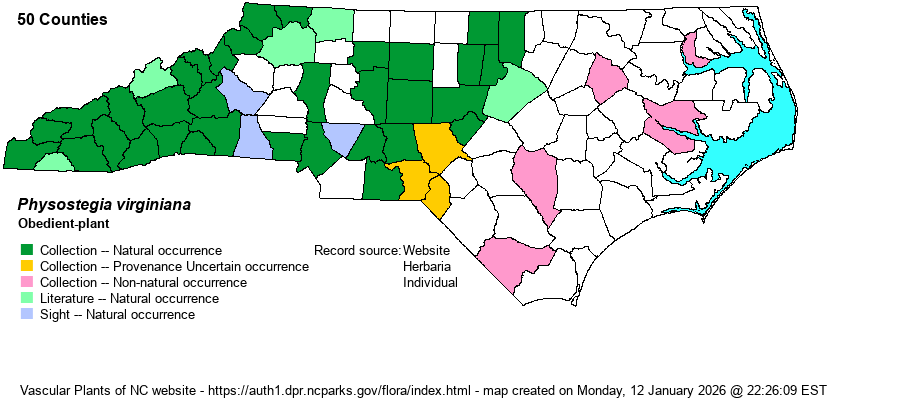| Author | (L.) Bentham | |
| Distribution | Present over most of the Mountains, and scattered over most of the Piedmont; perhaps present in all Mountain counties and eventually in most in the Piedmont, but many holes in the Piedmont range. Scattered records for the Coastal Plain are likely not natural. As this species is widely planted, the website editors have chosen not to use iNaturalist photos from downstate of the Mountains onto the map, especially as many records are from cities and towns.
This is a widely ranging species, but as it frequently escapes, much of the southern portions are not of natural populations. Ranges as a native from Canada south to central NC, but farther south of uncertain provenance. | |
| Abundance | Uncommon to infrequent in the Mountains. Rare in the northwestern Piedmont, but slightly more frequent farther east and south, though still mostly uncommon in the central and eastern Piedmont, and very rare in the northeastern portions. Presumed introduced or escaped in the Coastal Plain. This species is not as numerous as Weakley's (2018) map shows; it says "common" for both the Mountains and Piedmont, but it is clearly an uncommon native in NC. Even the NCNHP's rank of S4 seems liberal, and the website editors feel that S3S4 is the better State Rank. | |
| Habitat | This species prefers somewhat high pH soils, and full to partial sunlight. Also, it grows best in damp (but not wet) sites, though it is not really a wetland species. It favors wet meadows, barrens and glades, seepages in open woods, damp thickets, among other sites. It does grow in open upland forests as long as the soil is quite high in pH. | |
| Phenology | Blooms from July to October, and fruits soon after flowering. | |
| Identification | This is a familiar wildflower, even if seen only in cultivation. It is normally a slender, wand-like species with an unbranched to slightly branched stem, growing to about 2.5-3 feet tall. It has a large number of paired/opposite leaves, generally 12 or more pairs, and thus much leafier than are the other two Physostegia species in the state. Each leaf is 3-4 inches long, lanceolate, sessile, and strongly/sharply serrated. The top 4-6 inches of the stem contains a very dense raceme of bright rose-pink tubular flowers, each about 1-inch long, arranged horizontally, with an inflated middle of the tube. In this species, the flowers are often 4-ranked, as seen from above. Also, true to the alternate common name, if you push a flower to the left or right, it typically stays in place, as opposed to springing back to its original position in the cluster. As with other genus members, the species often grows in very dense stands. Perhaps unfortunately, for one reason or another the species is easily transplanted or at least easily escapes, and some sites within the normal range (i.e., within the mountains and Piedmont) might not be natural. Certainly, those in the Coastal Plain seem not natural, as specimens are from widely scattered counties with no obvious geographical pattern. | |
| Taxonomic Comments | Weakley (2018) lists two subspecies, as opposed to varieties, for this species in NC. The form ssp. praemorsa is the primary one, if not the only native one, in the state; on the other hand, ssp. virginiana is considered by him as native in NC but rare throughout. In theory, these overlapping taxa should be named as varieties, not subspecies. At any rate, for this website and species account, such subtleties in taxa and their distinguishing characters are to be left to Weakley (2018) and other references.
| |
| Other Common Name(s) | Northern Obedient-plant, False-dragonhead. Though the other two species in the genus in NC are named as "xxxx False-dragonhead", no reference gives a modifier name for this species, such as Virginia False-dragonhead. As most use the colloquial, though very well known, name of "Obedient-plant", the website is using this latter name. | |
| State Rank | S4 [S3S4] | |
| Global Rank | G5 | |
| State Status | | |
| US Status | | |
| USACE-agcp | FACW link |
| USACE-emp | FAC link |

